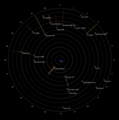Berkas:Angular map of fusors around Sol within 12ly.png

Berkas sujati (864x871 piksel, agengnyané berkas: 81 KB, soroh MIME:image/png)
Berkas puniki mawit saking Wikimedia Commons lan minab kaanggén antuk proyék-proyék sané lianan. Déskripsinnyané ring kaca déskripsi berkasnyané kaarahin ring sor puniki.
Ringkesan
| DéskripsiAngular map of fusors around Sol within 12ly.png |
English: This is a stellar map, employing an original map concept, which combines graphically the distance of all stellar systems or singular fusors (stars and brown dwarfs) and sub-brown dwarfs within 12 light-years (ly) or 3.7 parsecs from Earth, along with their angular location as viewed from Earth. The result provides a readable and correct depiction of the distance from the center (Earth/Sol) and location in three dimensional space of the described stellar objects, allowing a correct depiction of proximity among the depicted stellar objects.
How to read: This map is a common radar screen type of map displaying stellar objects around Sol. Each stellar object is marked jointly by two points, a diamond marked point and an line marked point, as well as an either unbroken or dotted straight line which connects the two points.
The circular lines indicate the distance from the map-center by being set apart in one light-year steps. At the outermost circular line the hours angle for the right ascension is displayed clockwise. The circular lines therefore represent the hour-axis and, through their repetition in one light-year steps, the distance-axis.
The straight lines (unbroken or dotted) represent the arcs of the declination angles (see also circular sector of a unit circle) of the stellar objects on their hour circle toward the celestial poles (with the poles being congruent with the center of the map). Since the map is viewed top-down from the south, allowing a clockwise eastward-reading (opposed to when using sidereal hour angles), the dotted straight lines are arcs with positive declination, down from the reference plane/level, toward the star Polaris, the northern celestial pole (which would be allmost congruent with the center of the map, if it would display stars further than 12 ly). That said the straight lines also represent a top-down view of the hypotenuse between the points of a right-angled triangle with its right-angle on the plane/level; but the straight lines, when viewed true to length, represent the base x-line of the described triangle.
x = "distance of the stellar objects to the map-center in ly" - ("distance of the stellar objects to the map-center in ly" * sin(180°-90°-"declination"))  Note: Proxima Centauri is the only marked stellar object not labled and not being an independent stellar object or the primary body of a stellar system (which in its case is Alpha Centauri), but still being noteworthy since it is the closest fusor to Sol.
Epoch J2000.0, see List of nearest stars and brown dwarfs. Produced with Microsoft Excel (radar chart) |
| Tanggal | |
| Wit | Kriya ngraga |
| Sang anyurat | Nsae Comp |
| Versi lainnya |
|
Lisénsi
- Ida kadadosang:
- Ngedum – Nyadur miwah nyobyahang malih suratan puniki ring wentuk utawi format napi ja
- Nyampuhang – Ngubah pakaryan puniki
- Ring sor kawéntenan puniki:
- atribusi – Ragané patut ngenahang krédit sané patut, ngicénin pranala lisénsinnyané, miwah nguningaang yéning ngardi uahan. Ragané prasida nglaksanaang nganggé tata cara sané sumakuta, nanging nénten mateges yéning sang ngicénin lisénsi nyokong ragané utawi panganggén ragané.
- wagiang pateh – Yening ragane nyampuh, ngubah, utawi ngwangun ring ajeng pakaryan, Ida patuh nyobyahang kontribusi druene ring ungkur lisensi sane pateh utawi kompatibel manut sujatinyane
Sesirah
Items portrayed in this file
menggambarkan Indonesia
Peta bintang Indonesia
pencipta Indonesia
some value
status hak cipta Indonesia
berhak cipta Indonesia
lisensi Indonesia
sumber berkas Indonesia
karya sendiri dari pengunggah Indonesia
3 Pébruari 2021
tipe media Indonesia
image/png
checksum Inggris
3455a7e2bf336a8278866ef78721355d9e109139
ukuran data Indonesia
83.359 Bita
tinggi Indonesia
871 piksel
864 piksel
Babad berkas
Klik ring tanggal/galah anggén nyingakin berkas puniki ri tatkala galah punika.
| Tanggal/Galah | Gambar alit | Diménsi | Sang anganggé | Panampen | |
|---|---|---|---|---|---|
| mangkin | 13 Pébruari 2021 22.58 |  | 864 × 871 (81 KB) | Nsae Comp | Positive declination as doted line, since view from the south. |
| 3 Pébruari 2021 22.56 |  | 868 × 875 (79 KB) | Nsae Comp | Uploaded own work with UploadWizard |
Panganggén berkas
Kaca nganggén berkas puniki:
Panganggén berkas ring jagat
Wiki lianan ring sor puniki nganggén berkas puniki:
- Panganggén ring en.wikipedia.org
- Panganggén ring id.wikipedia.org
Métadata
Berkas puniki madaging pidarta tambehan, minab katambehin saking kaméra digital utawi pemindai sané kaanggén ngardi utawi nigitalisasi.
Yéning berkasnyané sampun kamodifikasi saking kawéntenan witnyané, rincian saking witnyané minab nénten samian pateh malih saking berkas sané kamodifikasi.
| Résolusi horisontal | 37,79 dpc |
|---|---|
| Résolusi vértikal | 37,79 dpc |



